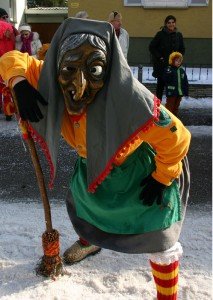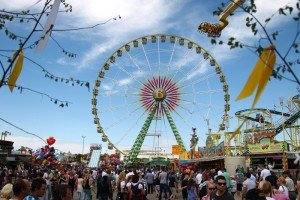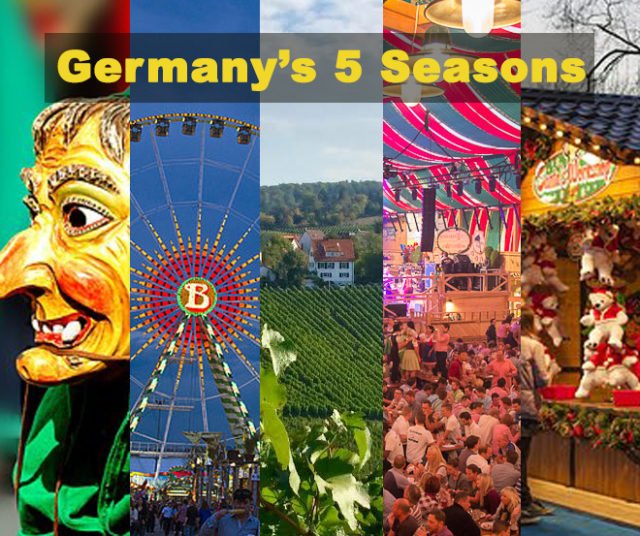Compiled By Teri Weiss, Carola Meusel & Holly DeCarlo-White
USAG Stuttgart Public Affairs Office
There are five seasons in Germany: spring, summer, fall, winter – and Fasching.
Fasching – Jan/Feb

In Germany, the terms vary regionally: Fasching, Fastnacht, Fasnet, or Karneval and are derived from different sources.
Fasching dates back to 1200 and originated from the Germanic word “vaschanc” or “vaschang,” meaning “Fastenschank,” which translates to the last serving of alcoholic beverages before Lent.
Fastnacht translates to “Nacht vor dem Fasten,” or the night before fasting. The Swabian word “Fasnet” comes from the Old German word “fasen,” meaning to be foolish, silly or wild.
Karneval, or carnival’s word origin is uncertain. Some believe it comes from ancient Greek processions and floats resembling ships, which the Romans later called a “carrus navalis.” Others think it may be based on the Latin term “carne levare,” which means away with meat, hence carnival.
No matter what you call it, for most Germans it’s a time to live it up with fests, parades, music and many “foolish” events the week before Ash Wednesday, when the 40-day Lent before Easter begins.
The Fasching season officially begins each year on Jan. 7, one day after Epiphany, or Three King’s Day.
In some areas, Fasching guilds commemorate the beginning of Fasching on Nov. 11 at 11:11 a.m. with local ceremonial events that prepare for the official start of the foolish season in January. During the middle ages, the number 11 represented the “Narrenzahl,” or fool’s number. Why 11? The number is sandwiched between the 10 biblical commandments and the 12 apostles of Jesus and, therefore, is not a holy number, according to an official of the “Gräbler” Fasching guild in Neuhausen.
Fasching Week
During Fasching parades in southern Germany, “Narren,” or Fasching fools, wearing wooden masks carved in the images of witches, devils and grotesque animals can be seen. Be on the lookout for Narren walking up to you to either ruffle your hair or drop you a piece of candy.
Weiberfasching or Women’s Carnival: Main events and parades start on “Schmotziger Donnerstag” (Greasy Thursday) or “Weiberfasching,” women’s carnival. The Swabian word “schmotzig” means lard or grease and refers to the opulent food eaten during Fasching, such as “Fasnetsküchle” or Krapfen (Fasching doughnuts).
In Stuttgart, Bad Cannstatt’s “Kübelesmarkt” Fasching association kicks off the events by setting up the “Narrenbaum,” or fool’s pole, at the Marktplatz, followed by a parade throughout the downtown area.
Neuhausen, just 15 kilometers outside Stuttgart, is another popular destination on Greasy Thursday with the “Hexentanz,” or witch’s dance, at Schlossplatz Square. Neuhausen’s Fasching fools storm the town hall and force the mayor to hand over the keys of the city. A huge bonfire is lit in celebration.
Small towns throughout Stuttgart will have similar events at the town hall through the month. The remainder of the Fasching week is Fasching Saturday and Sunday, Rose Monday and Fat Tuesday.
Fat Tuesday: During the evening of the “Fastnacht,” a witch is buried in a casket and the wild days end at midnight.

Spring: April/May
Stuttgarter Frühlingsfest, or spring fest, typically runs from mid April through the second week of May at the Cannstatter Wasen fest grounds in Bad Cannstatt.
The festival is one of the largest spring fests in Europe combining popular amusement park rides for all ages, with beer tents, shopping and local food.
Three beer tents — “Göckelesmaier,” “Grandl’s Hofbräu Zelt” and “Zum Wasenwirt” — offer roasted chicken or “Göckele,” freshly brewed fest beer, and live “Volksmusik,” or German folk music, party, country and rock tunes. Each fest tent also has a beer garden where visitors can enjoy food and drinks in the sun. Get table tickets online early to reserve a spot inside the tent. especially in the evenings or weekends.
A reconstruction of a typical Bavarian-Austrian Alp village, the “Almhüttendorf,” is set up in the middle of the Cannstatter Wasen fest grounds with outdoor, open seating too. Here, rustic booths offer “Schweinshaxe” (hambone) or a “Jause,” a snack consisting of bread, cold cuts, radishes and cottage cheese. This type of snack is normally served throughout Bavaria and Austria, while people take breaks during hiking trips.
Special family days are also offered on Wednesdays with discounted prices.
For information and table reservations, visit http://wasen.de.
Summer – July/Aug
Checkout Stuttgart pools and outdoor activities here.
Hamburger “Fischmarkt” Fish Market: 10-day fest in mid July in Karlsplatz Square. For information visit www.fischmarkt.events/stuttgart.
Stuttgart’s ‘bean quarter’ Festival: A street festival the last weekend of July located between Charlottenplatz and Leonhardsplatz squares. Most stores are open all evening throughout the three days of the event, plus live music and food offerings. For information visit www.bohnenviertel-stuttgart.de.
Sommerfest: A four-day fest in the beginning of August (starting Thursdays) featuring food, wine and live music performances. The fest spans from Schlossplatz and the Neues Schloss to the State Opera.
Fall Sept/Oct
“Weindorf” wine fest: 12-day fest end of August through first week in September. The fest spans from Marktplatz Square to Kirchstrasse and the Schillerplatz Square. For information visit www.stuttgarter-weindorf.de/english.
Stuttgart’s Volksfest, or the people’s festival, is the second largest festival at the Canstatter Wasen fair grounds in Bad Cannstatt, right along the local transit lines: S-Bahn and U-Bahn in Stuttgart. There are nine large beer tents plus outdoor seating, amusement rides, shopping and food for all ages. It is a larger version of Stuttgarter Frühlingsfest in the spring. Special family days are held on Wednesdays. Tables inside tents sell out quickly, so book in advance. For information and table reservations, visit http://wasen.de.
Munich’s Oktoberfest is the world’s largest festival, two and a half hours by train or by car from Stuttgart featuring 14 large tents and more than 20 smaller ones. The train is the safest and easiest bet to get to the fests. For information on tables and transportation, visit www.oktoberfest.de/en.

The Holiday Season
In Germany, Christmas casts a magical spell on cold and dark winter days. The highlight of winter is going to the many local Christmas markets for a mug of hot Glühwein (mulled wine) or warm punch.
The holiday season in Germany officially begins with Advent.
St. Nikolaus’ Day, Dec. 6 marks the birthday of Nikolaus, Bishop of Myra (known today as Turkey). Children place one of their boots outside their doors on the night of Dec. 5 in hopes that St. Nikolaus will leave candy, gingerbread, toys, tangerines and nuts in their shoe.
Christmas Eve is celebrated with close family. Traditionally, the gift exchange takes place in the afternoon, followed by a festive meal, from goose with red cabbage, dumplings or potatoes, to fish, or, typical for Swabia, Saitenwürstle (sausages) with potato salad.
“Fröhliche Weihnachten” or Merry Christmas! Many people in Germany visit extended family and friends on Dec. 25 and 26, also called the first and second Christmas days. Germans typically take their Christmas trees down by Epiphany on Jan. 6, which is also known as Three Kings Day across Europe. This day is a holiday as well and celebrated with parades and festivities to welcome the kings.
New Year’s in Stuttgart is a busy night but also a time to think about safety. Fireworks are only for sale in Germany right before the new year and people are allowed to light fireworks in the streets. Be mindful of your surroundings on New Year’s Eve.
_______________________
Off-Post Culture Calendar: To view more events and cultural activities in Stuttgart, check out the Culture Events section and calendar at www.stuttgartcitizen.com/culture-leisure.

